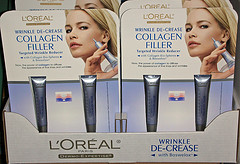| Helium Ion Microscopy of collagen (Photo credit: ZEISS Microscopy) |
Skin rejuvenation peptides are cosmetic dermatology’s answer to retinoids. Retinoids stimulate collagen production at the transcriptional level by directly interacting with nuclear receptors. The skin rejuvenation peptides trick the body into synthesizing more collagen.
Collagen production and its ultimate destruction by a group of enzymes called MMPs are controlled by a complicated system of signal molecules. The skin rejuvenation peptides supposedly resemble collagen degradation particles and trigger the synthetic pathway to compensate for the perceived degradation.
The short peptide KTTKS from alpha-procollagen-I is the most successful peptide within this category that is being extensively used. However three factors limit the efficacy of peptides.
- Stability in the base formulation
- Penetration across the cell membrane
- The predilection for enzymatic destruction inside the cell.
The last and the often ignored limitation is its propensity to catalytically increase hyaluronic acid degradation along with UVB.(1) Though peptides may have a positive effect on chronological ageing, its overall effect on photo ageing needs to be studied.
Several modifications have been suggested and tried for KTTKS to circumvent the above limitations. The addition of a palmitoyl group to increase penetration was the most successful modification and palmitoyl-KTTKS was the industry standard anti-ageing peptide for a long time.
| L’Oreal Collagen Filler (Photo credit: ATIS547) |
Recently a new tetrapeptide called tetrapeptide-21 has emerged as a collagen enhancer more effective than palmitoylKTTKS.(2) The inventors have demonstrated the superiority by several ex-vivo studies. They claim to have arrived at this molecule by using bioinformatics methods. They collected the sequence of all collagen and elastin. They extracted the most commonly occurring tetrapeptide sequence among these molecules. From 30 or so commonly occurring tetrapeptides with the general formula GxxG and PxxP, they tested by ex-vivo methods and found the most effective one, GEKG. GEKG is claimed to have a beneficial effect on hyaluronic acid as well.(3)
But there are several limitations with their bioinformatics methodology:
- Type I and III collagen are the most common types in skin. Why did they include all?
- How can they claim that the most commonly occurring tetrapeptide is the most potent signal peptide for collagen synthesis.
Studies have shown other limitations of their methodology.(4) I recently came across a new algorithm to predict the potential short peptide signal molecules within proteins based on conserved domains. I used the new algorithm to analyze collagen III. I found that the common tetrapeptide repeats are those proposed by tetrapeptide21 inventors. However the highest scoring short peptide based on the above algorithm was different.
I believe, I have discovered a short peptide out of millions of probable short peptides within collagen that is most likely to mimic the signal molecule for collagen production. Cosmetic companies may find this short peptide interesting. However further refinement may be needed to improve penetration and stability. Besides my theoretical prediction needs experimental proof.
References:
- Röck, Katharina et al. “Collagen Fragments Inhibit Hyaluronan Synthesis in Skin Fibroblasts in Response to Ultraviolet B (UVB) NEW INSIGHTS INTO MECHANISMS OF MATRIX REMODELING.” Journal of Biological Chemistry 286.20 (2011): 1826818276.
- Mentel, M et al. “Innovative Peptide Technologies for Even, Young and Healthy Looking Skin.” SOFW JournalSeifen Ole Fette Wachse 138.3 (2012): 22.
- “TEGO® Pep 417.” 2009. 28 Mar. 2013
- Neduva, Victor et al. “Systematic discovery of new recognition peptides mediating protein interaction networks.” PLoS biology 3.12 (2005): e405.
Read the full series on peptides here.

- Machine learning-based BOTOX API - April 11, 2023
- Skinmesh: Machine learning for facial analysis - November 10, 2020
- Free Dermatology EMR for Machine Learning and Artificial Intelligence - January 2, 2020










Hello,
This is such a nice post with different types of peptides.These peptides are very effective for our health.Thank you much more…
Buy Peptides